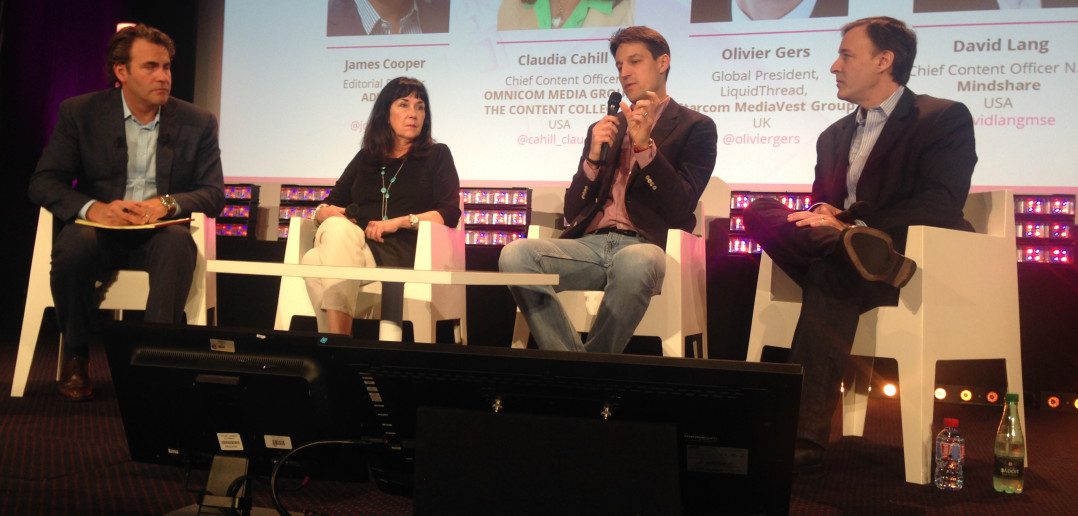Left to right: Moderator James Cooper, editorial director of Adweek; CCO Claudia Cahill of Omnicom Media Group; Olivier Gers, vice president of LiquidThread at Starcom MediaVest Group; CCO David Lang of Mindshare.
The Storytelling Singularity, which continues our “Brands as Programmers” track in partnership with Adweek, was more about the tenuous role data plays in the game of pleasing clients and entertaining users.
Cahill, Gers and Lang began by sharing choice case studies which mixed rich storytelling, programmatic savvy and a strong command of data.
“What we all do is a balance between science, data and creativity,” said Lang. “What gets lost is that data doesn’t engage consumers. Story does. If you don’t create things a consumer will be interested in, the data doesn’t matter.”
But there are brands that are starting to understand the importance of strong content in and of itself. “We have clients at this point producing content with no brand role; they’re doing it from an investment standpoint,” said Cahill.
This is crucial for today’s consumers, who have become selective about when and in what context they’ll accept a brand intervention. Millennials specifically are “willing to accept the role of the brand but it has to be very specific,” she said.
Gers jumped on that point and insisted it’s important to educate brands on investing in long-term branded content production versus just one-offs. “Of course, both have their place in the market,” he said, then lifted his hands: “but we’re all struggling…”
“What we’re finding is that when you customise content, and can do it efficiently and economically, and can reach across channels, it’s not just an awareness or consideration play anymore,” said Lang. Such cohesive strategies can lead to “complete content architectures for other clients,” which can make them more responsive to Millennial demands.
“Disruption is real,” Gers stated. “We’re looking at the numbers every day, and it’s because Millennials are coming in, behaving differently than we do. I have two at home and they haven’t turned on the TV in over a month. But they watch a ton of content: On-demand, in streaming … and I think we as industries need to evolve the way we reach them.”
The conversation naturally drifted toward content planning for the long-term, and finding ways to fit that into an existing production cycle.
“A lot of what we’re doing now is content strategy, especially for retail clients,” said Cahill. “They need to speak to those consumers on an ongoing basis, so the work we do now addresses their annual planning in a different day. We look at their owned, earned and paid assets to see where content fits”—work she calls crucial to “getting away from the whole one-off thing that we all deal with.”
The need to plan content raises the question of what the difference is between communications planning and content planning. For Lang, the latter is simply, “What is the role of content in your over-arching communications plan? Then [people ask], “what’s the difference between content and advertising?'” Content tells a consumer what you stand for, and advertising tells a consumer what you want them to buy, Lang stressed.
There is a difference, he added, between product placement and product integration—paid versus earned. It’s important to find a balance, panelists agreed.
Check out MIPTV, MIP Digital Fronts, MIPDoc & MIPFormats 2015 full live coverage




